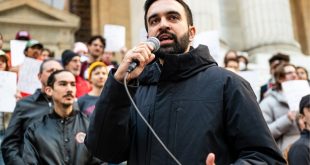 When horrible things happen, such as the tragic mass murder that occurred at Emanuel AME Church in Charleston, South Carolina, we try to understand because it is through understanding that we solve problems.
When horrible things happen, such as the tragic mass murder that occurred at Emanuel AME Church in Charleston, South Carolina, we try to understand because it is through understanding that we solve problems.
Speaking about the incident, Hillary Clinton said: “It is tempting to dismiss a tragedy like this as an isolated incident — to believe that in today’s America, bigotry is largely behind us, that institutionalized racism no longer exists. But despite our best efforts and our highest hopes, America’s long struggle with race is far from finished.”
Some of the Republican candidates for president are taking heat because they have not come out so boldly and clearly as Clinton regarding the racial dimension of this crime.
Here’s the problem. No one, particularly with all the information we now have about the deranged young man who admitted to committing this crime, can question his racial motivations. He was a sick, pathological racist.
But Clinton, in her zeal to make political capital from this tragedy, conflated and confused very different things — racial bigotry and institutionalized racism – and as result, at a difficult and sensitive moment, threw out heat when we needed light.
Institutionalized racism is racism that a society officially endorses. It is present when there is a legal framework that supports it.
Institutionalized racism existed in the United States prior to the passage of the Civil Rights Act of 1964 and the Voting Rights Act of 1965. Social realities and laws that permitted racial discrimination of various kinds were made illegal by those acts.
So Clinton misrepresents reality to suggest that “institutionalized racism” exists today in America. It does not.
Racial bigotry, on the other hand, is personal behavior. Does it exist? It certainly does. But personal affairs of the heart and affairs of state are different issues.
As Martin Luther King Jr. observed, “morality cannot be legislated, but behavior can be regulated.
Judicial decrees may not change the heart, but they can restrain the heartless.”
The civil rights-era laws purged America of legal, institutionalized racism in the spirit of Dr. King, restraining “the heartless.”
But why, a half-century later, does so much sick personal racial bigotry remain? Why does there remain such a sharp racial consciousness? Why does it remain so prevalent that individuals are judged by the color of their skin rather than the content of their character?
A good deal of this is driven by the refusal of so many — mostly liberals such as Clinton — to accept King’s simple but profound point that racial bigotry is a moral problem and that “morality cannot be legislated.”
The plethora of government programs driven by the pretense that government can go beyond just protecting citizens to become an active tool for creating a more just society have worsened the very problem they pretend to address. Making segregation illegal — making discrimination illegal — is far different from forced integration and mandated quotas.
Liberal policies have forced ongoing and increased racial consciousness and division in the country. In doing so, by taking government where it does not belong, trying to solve a moral problem it cannot solve, they have made the problem worse and sharpened, rather than eased, racial tensions.
Worse, taking government where it does not belong has diminished the most important factor needed to solve this problem, which is more, not less, personal moral responsibility by both the victims and the victimizers.
Appreciation for the awesome humility, forgiveness and love demonstrated by the families of the victims of this horrible crime and the other members of this church is the greatest homage we can pay to those who were murdered.
As a nation, we should be turning to the God to whom they were praying, whose teachings they were studying when they were murdered. The answers are there. Not in politics and not in Washington.
Photo credit: CURE
COPYRIGHT 2015 STAR PARKER
DIST. BY CREATORS.COM
 CURE News and Clergy Blog News and Commentary for Christians
CURE News and Clergy Blog News and Commentary for Christians




On Sunday morning, I turned on CNN @ 9:30. The worship service at Mother Emmanuel Church was well under way. For the next two hours, I watched those people “do church” like I’ve not seen in a long time. They were obviously hot, as witnessed by the fanning, so I’m guessing that the sanctuary did not enjoy the benefit of air conditioning under a brutal Charleston sun. I have never witnessed a clearer devotion to the Gospel under extreme conditions, by a congregation that had just suffered one of the worst tragedies that anyone would experience — a massacre by a white extremist. There was none of the indulgence in the kind of political rhetoric that has become the stock & trade of people like Al Sharpton or Jeremiah Wright. I was particularly struck by the bishop’s prayer. Totally unscripted, and full of references to scripture & the Gospel. These people are the real deal. Their fidelity to the Gospel left me feeling like the Centurion witnessing the crucifixion of Christ. What is more, I was moved by the largely white crowd that stood for over 2 hours in the boiling sun to demonstrate their solidarity with this congregation. As a long term resident of SC, I have never been more proud of my state, or more moved by what I saw that day. These people showed the way forward.
“As a nation, we should be turning to the God to whom they were praying, whose teachings they were studying when they were murdered. The answers are there. Not in politics and not in Washington.” Amen to that!!!